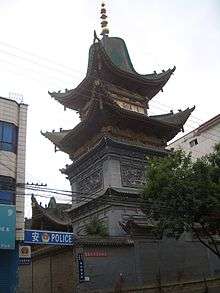Gongbei (Islamic architecture)

Gongbei (Chinese: 拱北; pinyin: Gǒngběi; from Arabic: قُبّة (qubba),[1] Persian: گنبد gonbad,[1] meaning "dome", "cupola"), is a term used by the Hui people in Northwest China for an Islamic shrine complex centered on a grave of a Sufi master, typically the founder of a menhuan (a Chinese Sufi sect, or a "saintly lineage"). The grave itself usually is topped with a dome.[1] [2]
A similar facility is known as dargah in a number of Islamic countries.
Between 1958 and 1966, many Sufi tombs in Ningxia and throughout northwestern China in general, were destroyed, viewed by the authorities as relics of the old "feudal" order and symbols of the criticized religion, as well as for practical reasons ("wasting valuable farmland"). Once the freedom of religion became recognized once again in the 1980s, and much of the land reverted to the control of individual farmers, destroyed gongbeis were often rebuilt once again.[3]
See also
References
| Wikimedia Commons has media related to Gongbei. |
- 1 2 3 Lipman, Jonathan Neaman (1998). Familiar strangers: a history of Muslims in Northwest China. Hong Kong University Press. p. 61. ISBN 962-209-468-6.
- ↑ Joseph Fletcher, The Sufi Paths (turuq) in China”, Etudes Orientales 13/14 (1994). Quoted in: Dru C. Gladney (1996). Muslim Chinese: ethnic nationalism in the People's Republic. (Volume 149 of Harvard East Asian monographs). Harvard Univ Asia Center. p. 41. ISBN 0-674-59497-5.
- ↑ Gladney, Dru. "Muslim Tombs and Ethnic Folklore: Charters for Hui Identity" Journal of Asian Studies, August 1987, Vol. 46 (3): 495-532; p. 53 in the PDF file.
